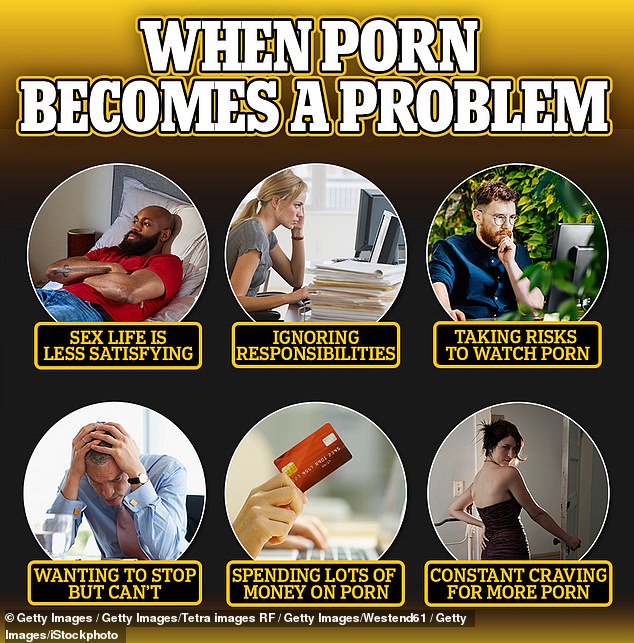Is porn addiction real? How to tell if you have it and what to do about it
About 200,000 Americans classify themselves as porn addicts, although the medical community has still not reached a consensus on whether the condition is an addiction at all.
There’s a crucial difference between watching porn occasionally, which can be a normal part of healthy sexuality, and being so consumed by the explicit fantasy scenarios that sex with a real partner loses its luster.
Porn is not like alcohol or drugs, and many mental health and addiction experts say that people cannot become addicted to porn itself because it is not a substance nor does it change the chemistry of a person’s brain. Some experts say it’s more likely a person’s own personal conflicts around sex, such as shame, that convince them they’re addicted.
Yet there is a neurological underpinning to support the arguments that compulsive viewing of pornography, like alcohol and stimulants, floods the brain with feel-good chemicals that make people want more.
Millions of people watch porn as an escape from their daily anxieties or relationship problems, but it becomes a problem when the user has given up normal responsibilities, both professional and personal, and when relationships, such as with a monogamous partner, become strained.

Porn can be a healthy part of a person’s sex life, but when it starts to impact other aspects of life, such as family time and work responsibilities, it can become a problem.


About three to six percent of the U.S. adult population engages in problematic pornography use, or what they consider a porn addiction
Seventy percent of men between the ages of 18 and 34 visit a porn site in a normal month.
Even young people, especially teenage boys who make up the largest porn consumer group, have relatively easy access to explicit sexual content, especially considering the importance of online porn. 12 percent of all internet sites.
A study by Indiana University’s Kinsey Institute for Research in Sex, Gender, and Reproduction found that nine percent of porn viewers wanted to quit, but discovered they couldn’t.
When people, especially men, find themselves withdrawing from their partners and losing satisfaction in sexual relationships, becoming desensitized and having to consume more extreme content, and putting aside responsibilities to spend more time on porn, this could be a sign of a porn -addiction. addiction – despite many leading authorities in psychology and addiction research insisting that it is not a true addiction.
Although the problem is more common in men, one in six women report struggling with a porn addiction.
The American Psychological Association, the nation’s leading authority on advancing mental health research and the largest professional organization for psychologists, does not recognize the habit as an addiction.
Furthermore, the Diagnostic and Statistical Manual of Mental Disorders, the authoritative guide to diagnosing mental disorders used around the world, also written by the APA, does not recognize porn addiction as an official diagnosis.
The reason has its origins in the ongoing debate about what lies behind a ‘porn addiction’. One camp of psychologists, including Dr. Vincent Egan and Dr. Reena Parmar of the University of Leicester in Britain, say that uncontrollable porn consumption may be a compulsive addiction rather than an actual one.
In a 2013 report published in the Journal of Sex & Marriage TherapyDrs. Egan and Parmar said: ‘Our results lend themselves to the practical and clinical consideration of treatment and therapy for sexually compulsive individuals, or for people who excessively engage in Internet pornography.’
Meanwhile, some believe that what people might consider an addiction is more an expression of a person’s cultural or religious beliefs that shape how they view sex.
For example, someone who grew up in a very religious and/or conservative home may feel extremely ashamed of watching porn and convince themselves that they must be addicted.
Dr. Nicole Prause, a neuroscientist who specializes in sex psychology said: “On average, porn has a positive impact on the vast majority of adults who choose to watch it.
‘The best predictor of fear of watching porn is having a conservative or religious upbringing, and this fear appears to disappear on its own without intervention in longitudinal studies (i.e., people tend to get over their concerns naturally to grow as they understand sexuality better).’
The lack of consensus means that there is no standard treatment for what could be considered a porn addiction. Like sex addiction, another controversial diagnosis in the field of psychology for similar reasons, many people find relief in 12-step programs that first start with admitting that porn is an out-of-control problem.
Treatment may also involve one-on-one talk therapy with a licensed professional, which is known as cognitive behavioral therapy. And there are specific mental health practices for sex and porn addiction.
